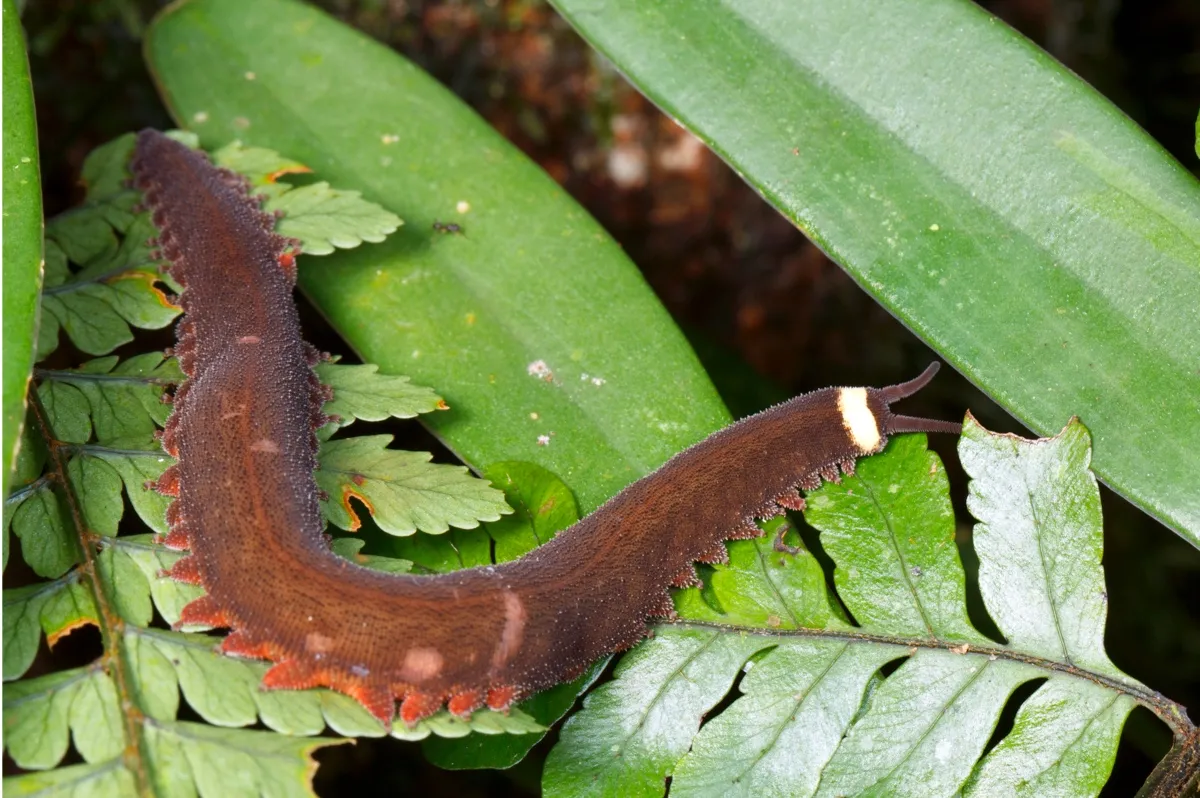You may have seen them marching through the undergrowth on Sir David Attenborough's Our Planet on Netflix, and been amazed/disgusted by their intriguing method of capturing their prey by jetting sprays of goo from their face. But there's so much more to these these funny (oddly cute) invertebrates, which have remained pretty much unchanged for millions of years.
What is a velvet worm?
Currently, some 230 species of velvet worms have been described. All velvet worms have a worm-like appearance, but they also have legs. This can cause some confusion, with people thinking they are a type of caterpillar or slug. They are neither; they belong to a group all to themselves called Onychophora.
Their common name comes from their velvety appearance, which is due to them being covered in tiny, delicate rows of scales. This coating makes them hydrophobic, or water-resistant. They can be pretty colourful, and can be found in hues of orange, brown, red and blue, with some species having stripes or blotches.
Depending on the species, they will have between 13 and 43 pairs of legs, with each foot tipped with a tough little claw. In fact, Onychophora means ‘claw-bearer’ in Greek. When walking on soft surfaces, the animals will retract their claws and stroll along on their foot pads. When the terrain becomes more uneven, they’ll use their claws to give themselves greater traction.
Velvet worms also have two wiggly antennae on their head, and a pair of modified legs called ‘oral tubes’. Most species also have a pair of simple eyes.
These weird animals can exhibit some interesting behaviour. They have small, yet highly complex brains, meaning they are capable of being pretty sociable. Research from the University of Queensland published in 2005 suggested that one particular species, Euperipatoides rowelli, will live and hunt in groups of 15 velvet worms. These individuals will fight to establish a pecking order, and will be ruled by a dominant female who gets first dibs at the choicest morsels. Any outsiders who fancy having a go at the group will be greeted with severe aggression.
They also have extremely varied life histories: some velvet worm species will lay yolk-filled eggs; others are retained as eggs inside the mother, until they hatch and emerge from her genital opening; still others will give birth to live young.
Read more about invertebrates:
How long have velvet worms been around for?
These little beasts share a striking resemblance to lobopodian fossils from the Early Cambrian, some 540 million years ago. An article published in Current Biology in 2016 suggests they first made their way onto land some 400 million years ago, and their modern body plan was formed 300 million years ago.
Velvet worms alive today are split into two major subgroups, the Peripatidae and Peripatopsidae. It is thought that they diversified when the ancient landmass of Gondwana split during the Jurassic. The Peripatidae tend to have a more equatorial distribution, whereas the Peripatopsidae live in the southern hemisphere. There are no known species in the northern hemisphere.
They are sometimes taxonomically grouped with tardigrades and arthropods, but this classification is not set in stone.
Where do velvet worms live?
Velvet worms inhabit equatorial regions and tropical and temperate areas in the southern hemisphere. They live in dark environments with high humidity, such as rainforests. They lurk in leaf litter, and under rotting tree trunks and stones, and tend to be more active at night or in rainy weather. A couple of species are cave-dwellers. Even in suitable environments, they never occur in high numbers. They can, however, exploit habitats created by humans, such as banana plantations.
How big is a velvet worm?
Depending on the species, velvet worms can vary from 1cm to more than 20cm in length. Most are around 4cm long.
What does a velvet worm eat?
A velvet worm will happily eat any small invertebrate, such as woodlice, millipedes, worms, snails and cockroaches.

How does a velvet worm catch its prey?
Despite their gentle-sounding name, velvet worms are vicious ambush predators. They will emerge at night and slowly creep around on the forest floor on their stubby legs. They will use their sensitive antennae and skin to seek out their prey. Once they find something, they will very gently touch it, in order to establish whether or not it is worth attacking. Once they’ve made their decision, BLAM! The velvet worm squirts extremely sticky, protein-based slime from their oral tubes at speeds of between three to five metres per second to ensnare the unfortunate prey. The more the animal struggles, the more it becomes entangled. Curiously, the slime does not stick to the velvet worm.
Once the prey is trapped, the velvet worm will approach and attack it with their sickle-shaped jaws. They'll also add a squirt of digestive juices for good measure, to make the invertebrate easier to slurp up. The velvet worm will eat any slime that was jetted out, as it’s a valuable resource that can take around three weeks to replace once exhausted. Anyone fancy a milkshake?
How rare are velvet worms?
Like many invertebrates, there is a lack of data for velvet worms. This is made doubly difficult because of their low population densities and nocturnal habits. Their main threat is loss of habitat, due to deforestation, draining of wetlands, and increased agriculture. So far, there are 11 species on the IUCN Red List of Threatened Species, which perhaps highlights the importance of protecting velvet worms and their habitats.
